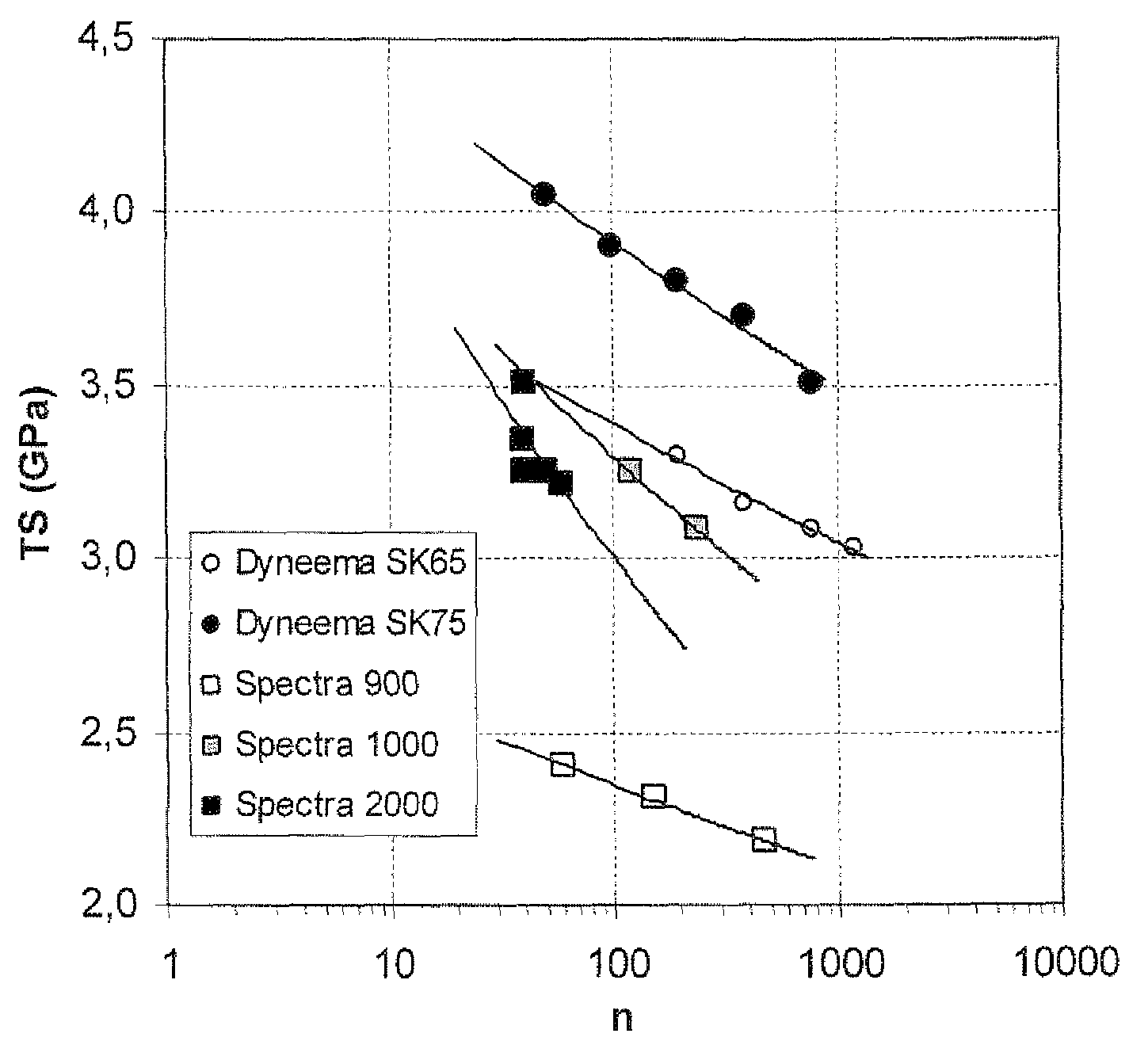Ballistic-resistant assemblies with monolayers of high-performance polyethylene multifilament yarns
a multi-filament yarn, ballistic-resistant technology, applied in the direction of synthetic resin layered products, prosthesis, protective garments, etc., can solve the problems of increasing the difficulty of spinning high-strength multi-filament yarn, and achieve the effect of higher tensile strength
- Summary
- Abstract
- Description
- Claims
- Application Information
AI Technical Summary
Benefits of technology
Problems solved by technology
Method used
Image
Examples
examples 1-2
[0070]A 6 mass % solution of a UHPE homopolymer having less than 0.3 side groups per 1000 per carbon atoms and an IV of 27.0 dl / g in decalin, containing a ratio of cis / trans isomers of between 38 / 62 and 42 / 58, was made, and extruded with a 25 mm twin screw extruder equipped with a gear-pump at a temperature setting of 180° C. through a spinplate having 24 spinholes into a nitrogen atmosphere with a rate of 1.0 g / min per hole. The spinholes had an initial cylindrical channel of 3.0 mm diameter and L / D of 18, followed by a conical contraction with cone angle 45° into a cylindrical channel of 1.0 mm diameter and L / D of 10. The solution filaments were cooled in a water bath kept at about 35° C. and with a water flow rate of about 5 cm / s perpendicular to the filaments entering the bath, and taken-up at such rate that a draw ratio of 15 was applied to the as-spun filaments in the air-gap of 15 mm. The filaments subsequently entered an oven at 130° C. The filaments were further stretched b...
example 3
[0073]This experiment is performed analogously to the foregoing, with following modifications: the spinplate has an inflow channel of diameter 4.5 mm and L / D=10, a contraction zone with cone angle 20°, and subsequent channel of diameter 0.3 mm and L / D of 5, resulting in a DRsp of 225; the draw ratio in the air-gap is about 1.01 by matching take-up speed with flow speed. With the draw ratio applied to the solidified filaments set at 5, the resulting yarn shows extremely high tensile strength and modulus.
Comparative Experiments B-C
[0074]In these experiments a solution of a UHPE polymer having less than 0.3 side groups per 1000 per carbon atoms and an IV of 19.8 dl / g in decalin was extruded with a 40 mm twin screw extruder equipped with a gear-pump at a temperature setting of 180° C. through a spinplate having 195 spinholes into an air-gap with a rate of 2.2 g / min per hole. The spinholes had the same geometry as in Ex 1-2, but with cone angle 60°. In exp. B an 8 mass % solution was use...
examples 4-5
[0075]The same spinning and drawing equipment and conditions as in Comp. Exp. B-C were used, but with a spinplate having an inflow channel of diameter 3.5 mm and L / D=18, a contraction zone with cone angle 60°, and subsequent channel of diameter 1.0 mm and L / D of 10, resulting in a DRsp of 12.25. The spin rate was 1.7 g / min per hole. The draw ratio in the air-gap could be increased, resulting in stable production of very high strength yarn, see Table 1 and FIG. 2.
PUM
| Property | Measurement | Unit |
|---|---|---|
| tensile strength | aaaaa | aaaaa |
| length/diameter ratio | aaaaa | aaaaa |
| length/diameter ratio | aaaaa | aaaaa |
Abstract
Description
Claims
Application Information
 Login to View More
Login to View More - R&D
- Intellectual Property
- Life Sciences
- Materials
- Tech Scout
- Unparalleled Data Quality
- Higher Quality Content
- 60% Fewer Hallucinations
Browse by: Latest US Patents, China's latest patents, Technical Efficacy Thesaurus, Application Domain, Technology Topic, Popular Technical Reports.
© 2025 PatSnap. All rights reserved.Legal|Privacy policy|Modern Slavery Act Transparency Statement|Sitemap|About US| Contact US: help@patsnap.com



